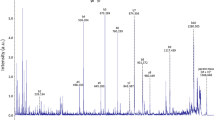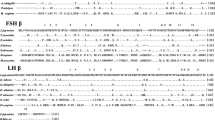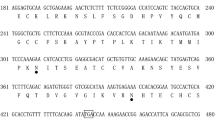Abstract
Gonadotropin inhibitory hormone belonging to the RFamide peptide family, a hypothalamic neuropeptide, regulates Hypothalamus-pituitary–gonadal (HPG) axis and inhibits gonadal development. GnIH polypeptide precursor has an Arg-Phe-NH2 (RFamide) motif at the C-terminal, which has LPXRF (X = Q or L) domain. The actions of GnIH are mediated through G-protein coupled receptors and upto three receptors have been characterized in many teleosts. GnIH exerts its inhibitory effect on the HPG axis through direct interaction with GnRH and Kisspeptin neurons in the brain and acts directly on the pituitary gonadotrophs. To decipher the role of GnIH in Indian freshwater murrel, Channa punctatus, we sequenced the cDNA encoding GnIH and its two receptors. The identified GnIH mRNA encodes three RFamide peptides having -MPMRF, -MPQRF, and -LPQRFamide motifs. In silico analysis of the amino acid sequence of GnIH exhibits its molecular and functional properties and the protein–protein interaction with significant factors regulating the HPG axis. The 3-D structure of GnIH and its receptors, provides more relevant information about the active residues of these proteins which might be involved in their functioning and interaction with other proteins. Molecular dynamic simulation of GnIH protein has provided more insight into its dynamic behavior. The expression of GnIH and its receptors, shows an inverse correlation with gonadal development during the annual reproductive cycle.















Similar content being viewed by others
Data availability
The datasets generated during and/or analysed during the current study are available from the corresponding authors on reasonable request.
References
Abraham MJ, Murtola T, Schulz R et al (2015) GROMACS: High performance molecular simulations through multi-level parallelism from laptops to supercomputers. SoftwareX 1:19–25. https://doi.org/10.1016/j.softx.2015.06.001
Amano M, Moriyama S, Ligo M et al (2006) Novel fish hypothalamic neuropeptides stimulate the release of gonadotrophins and growth hormone from the pituitary of sockeye salmon. J Endocrinol 188:417–423. https://doi.org/10.1677/joe.1.06494
Ball JN (1981) Hypothalamic control of the pars distalis in fishes, amphibians, and reptiles. Gen Comp Endocrinol 44:135–170. https://doi.org/10.1016/0016-6480(81)90243-4
Biran J, Golan M, Mizrahi N et al (2014) LPXRFa, the piscine ortholog of GnIH, and LPXRF receptor positively regulate gonadotropin secretion in tilapia (Oreochromis niloticus). Endocrinology (united States) 155:4391–4401. https://doi.org/10.1210/en.2013-2047
Biran J, Levavi-Sivan B (2018) Endocrine control of reproduction, fish. In: Encyclopedia of Reproduction. Elsevier, pp 362–368. https://doi.org/10.1016/B978-0-12-809633-8.20579-7
Biswas S, Jadhao AG, Pinelli C et al (2015) GnIH and GnRH expressions in the central nervous system and pituitary of Indian major carp, Labeo rohita during ontogeny: An immunocytochemical study. Gen Comp Endocrinol 220:88–92. https://doi.org/10.1016/j.ygcen.2014.06.005
Braasch I, Gehrke AR, Smith JJ et al (2016) The spotted gar genome illuminates vertebrate evolution and facilitates human-teleost comparisons. Nat Genet 48:427–437. https://doi.org/10.1038/ng.3526
Brooks BR, Bruccoleri RE, Olafson BD et al (1983) CHARMM: a program for macromolecular energy, minimization, and dynamics calculations. J Comput Chem 4:187–217. https://doi.org/10.1002/jcc.540040211
Chomoczynski P, Sacchi N (1987) Single step method of RNA isolation by acid Guanidinium isothiocyanate-phenolchloroform extraction. Analit Biochem 162:156–159. https://doi.org/10.1016/0003-2697(87)90021-2
Claire M, Holland H, Hassin S et al (2002) The effects of long-term testosterone, gonadotropin-releasing hormone agonist and pimozide treatments on testicular development and luteinizing hormone levels in juvenile and early maturing striped bass, Morone saxatilis. Gen Comp Endocrinol 129:178–187. https://doi.org/10.1016/S0016-6480(02)00532-4
Copeland PA, Thomas P (1989) Control of Gonadotropin Release in the Atlantic Croaker (Micropogonias undulatus): Evidence for Lack of Dopaminergic Inhibition. Gen Comp Endocrinol 74:474–483. https://doi.org/10.1016/S0016-6480(89)80045-0
Dardente H, Simonneaux V (2022) GnRH and the photoperiodic control of seasonal reproduction: Delegating the task to kisspeptin and RFRP-3. J Neuroendocrinol 34:e13124. https://doi.org/10.1111/jne.13124
Dardente H, Birnie M, Lincoln GA, Hazlerigg DG (2008) RFamide-Related peptide and its cognate receptor in the sheep: cDNA cloning, mRNA distribution in the hypothalamus and the effect of photoperiod. J Neuroendocrinol 20:1252–1259. https://doi.org/10.1111/j.1365-2826.2008.01784.x
di Yorio MP, Pérez Sirkin DI, Delgadin TH et al (2016) Gonadotrophin-Inhibitory Hormone in the Cichlid Fish Cichlasoma dimerus: Structure, Brain Distribution and Differential Effects on the Secretion of Gonadotrophins and Growth Hormone. J Neuroendocrinol 28. https://doi.org/10.1111/jne.12377
Dufour S, Sebert ME, Weltzien FA et al (2010) Neuroendocrine control by dopamine of teleost reproduction. J Fish Biol 76:129–160. https://doi.org/10.1111/j.1095-8649.2009.02499.x
Gopurappilly R, Ogawa S, Parhar IS (2013) Functional significance of GnRH and kisspeptin, and their cognate receptors in teleost reproduction. Front Endocrinol 4:24. https://doi.org/10.3389/fendo.2013.00024
Habibi HR, van der Kraak G, Bulanski E, Peter RE (1988) Effect of teleost GnRH on reinitiation of oocyte meiosis in goldfish, in vitro. Am J Physiol-Regulat Integr Compar Physiol 255:R268–R273. https://doi.org/10.1152/ajpregu.1988.255.2.R268
Hess B, Bekker H, Berendsen HJ, Fraaije JG (1997) LINCS: A linear constraint solver for molecular simulations. J Comput Chem 18:463–1472. https://doi.org/10.1002/(SICI)1096-987X(199709)18:12%3c1463::AID-JCC4%3e3.0.CO;2-H
Hollingsworth SA, Dror RO (2018) Molecular Dynamics Simulation for All. Neuron 99:1129–1143. https://doi.org/10.1016/j.neuron.2018.08.011
Humphrey W, Dalke A, Schulten K (1996) VMD: visual molecular dynamics. J Mol Graph 14:33–38. https://doi.org/10.1016/0263-7855(96)00018-5
Kriegsfeld LJ, Feng Mei D, Bentley GE et al (2006) Identification and characterization of a gonadotropin-inhibitory system in the brains of mammals. P Natl Acad Sci USA 103:2410–2415. https://doi.org/10.1073/pnas.0511003103
Kumakura N, Okuzawa K, Gen K, Kagawa H (2003) Effects of gonadotropin-releasing hormone agonist and dopamine antagonist on hypothalamus-pituitary-gonadal axis of pre-pubertal female red seabream (Pagrus major). Gen Comp Endocrinol 131:264–273. https://doi.org/10.1016/S0016-6480(03)00012-1
Kumar P, Wisdom KS, Bhat IA et al (2020a) Molecular characterization of gonadotropin-inhibitory hormone (GnIH) gene and effect of intramuscular injection of GnIH peptide on the reproductive axis in Catla catla. Anim Biotechnol 31:335–349. https://doi.org/10.1080/10495398.2019.1597730
Kumar P, Kumar M, Wisdom KS et al (2020) Characterization, Docking and Molecular Dynamics Simulation of Gonadotropin-Inhibitory Hormone Receptor (GnIHR2) in Labeo Catla. Cell Physiol Biochem 54:825–841. https://doi.org/10.33594/000000272
Kumar P, Wisdom KS, Ram RK, Gireesh-Babu P, Nayak SK, Nagpure NS, Sharma R et al (2021) Gonadotropin inhibitory hormone receptors (GnIHRs): Molecular characterization and synergistic effect of different drugs in Indian major carp, Labeo catla. Gen Comp Endocrinol 314:113904. https://doi.org/10.1016/j.ygcen.2021.113904
Kumari P, Kumar M, Sehgal N, Aggarwal N (2022) In silico analysis of kiss2, expression studies and protein–protein interaction with gonadotropin-releasing hormone 2 (GnRH2) and luteinizing hormone beta (LHβ) in Heteropneustes fossilis. J Biomol Struct Dynamics 40:4543–4557. https://doi.org/10.1080/07391102.2020.1860820
Liu Y, Li S, Qi X et al (2013) A novel neuropeptide in suppressing luteinizing hormone release in goldfish, Carassius auratus. Mol Cell Endocrinol 374:65–72. https://doi.org/10.1016/j.mce.2013.04.008
Livak KJ, Schmittgen TD (2001) Analysis of relative gene expression data using real-time quantitative PCR and the 2-ΔΔCT method. Methods 25:402–408. https://doi.org/10.1006/meth.2001.1262
Lobanov MY, Bogatyreva NS, Galzitskaya O, v, (2008) Radius of gyration as an indicator of protein structure compactness. Mol Biol 42:623–628. https://doi.org/10.1134/S0026893308040195
Martoňák R, Laio A, Parrinello M (2003) Predicting crystal structures: the Parrinello-Rahman method revisited. Phys Rev Lett 90:075503. https://doi.org/10.1103/PhysRevLett.90.075503
Moussavi M, Wlasichuk M, Chang JP, Habibi HR (2012) Seasonal effect of GnIH on gonadotrope functions in the pituitary of goldfish. Mol Cell Endocrinol 350:53–60. https://doi.org/10.1016/j.mce.2011.11.020
Muñoz-Cueto JA, Paullada-Salmerón JA, Aliaga-Guerrero M et al (2017) A journey through the gonadotropin-inhibitory hormone system of fish. Front Endocrinol 8:285. https://doi.org/10.3389/fendo.2017.00285
Murakami M, Matsuzaki T, Iwasa T et al (2008) Hypophysiotropic role of RFamide-related peptide-3 in the inhibition of LH secretion in female rats. J Endocrinol 199:105–112. https://doi.org/10.1677/JOE-08-0197
Ogawa S, Parhar IS (2014) Structural and functional divergence of gonadotropin-inhibitory hormone from jawless fish to mammals. Front Endocrinol 5:177. https://doi.org/10.3389/fendo.2014.00177
Ogawa S, Sivalingam M, Biran J et al (2016) Distribution of LPXRFa, a gonadotropin-inhibitory hormone ortholog peptide, and LPXRFa receptor in the brain and pituitary of the tilapia. J Comp Neurol 524:2753–2775. https://doi.org/10.1002/cne.23990
Paullada-Salmerón JA, Cowan M, Aliaga-Guerrero M et al (2016) LPXRFa peptide system in the European sea bass: A molecular and immunohistochemical approach. J Comp Neurol 524:176–198. https://doi.org/10.1002/cne.23833
Paullada-Salmerón JA, Cowan ME, Loentgen GH et al (2019) The gonadotropin-inhibitory hormone system of fish: The case of sea bass (Dicentrarchus labrax). Gen Comp Endocrinol 279:184–195. https://doi.org/10.1016/j.ygcen.2019.03.015
Peng W, Cao M, Chen J et al (2016) GnIH plays a negative role in regulating GtH expression in the common carp, Cyprinus carpio L. Gen Comp Endocrinol 235:18–28. https://doi.org/10.1016/j.ygcen.2016.06.001
Peter RE, Chang JP, Nahorniak CS et al (1986) Interactions of catecholamines and GnRH in regulation of gonadotropin secretion in teleost fish. Recent Prog Horm Res 42:513–548. https://doi.org/10.1016/b978-0-12-571142-5.50016-1
Peter RE, Lin H-R, van der Kraak G (1988) Induced ovulation and spawning of cultured freshwater fish in China: advances in application of GnRH analogues and dopamine antagonists. Aquaculture 74:1–10. https://doi.org/10.1016/0044-8486(88)90080-4
Pipil S, Kumar V, Rawat VS et al (2015) In silico and in vivo analysis of binding affinity of estrogens with estrogen receptor alpha in Channa punctatus (Bloch). Fish Physiol Biochem 41:31–40. https://doi.org/10.1007/s10695-014-0003-z
Qi X, Zhou W, Li S et al (2013) Evidences for the regulation of GnRH and GTH expression by GnIH in the goldfish, Carassius auratus. Mol Cell Endocrinol 366:9–20. https://doi.org/10.1016/j.mce.2012.11.001
Rawat VS, Pipil S, Sharma L, Sehgal N (2013) Purification, characterization and expression of two vitellogenins in the Indian freshwater murrel Channa punctatus. Gen Comp Endocrinol 189:119–126. https://doi.org/10.1016/j.ygcen.2013.05.002
Revel FG, Saboureau M, Pévet P, Simonneaux V, Mikkelsen JD (2008) RFamide-related peptide gene is a melatonin-driven photoperiodic gene. Endocrinology 149:902–912. https://doi.org/10.1210/en.2007-0848
Sawada K, Ukena K, Satake H et al (2002) Novel fish hypothalamic neuropeptide: Cloning of a cDNA encoding the precursor polypeptide and identification and localization of the mature peptide. Eur J Biochem 269:6000–6008. https://doi.org/10.1046/j.1432-1033.2002.03351.x
Sehgal N, Goswami SV (1994) Steroidal effects on plasma vitellogenin levels in intact and hypophysectomized Indian freshwater murrel, Channa punctatus (Bloch). Indian J Exp Biol 32:387–392
Servili A, Herrera-Pérez P, del Rendón MC, Muñoz-Cueto JA (2013) Melatonin inhibits GnRH-1, GnRH-3 and GnRH receptor expression in the brain of the European sea bass, Dicentrarchus labrax. Int J Mol Sci 14:7603–7616
Shahjahan M, Ikegami T, Osugi T et al (2011) Synchronised expressions of LPXRFamide peptide and its receptor genes: Seasonal, diurnal and circadian changes during spawning period in grass puffer. J Neuroendocrinol 23:39–51. https://doi.org/10.1111/j.1365-2826.2010.02081.x
Smith JT, Coolen LM, Kriegsfeld LJ et al (2008) Variation in kisspeptin and RFamide-related peptide (RFRP) expression and terminal connections to gonadotropin-releasing hormone neurons in the brain: A novel medium for seasonal breeding in the sheep. Endocrinology 149:5770–5782. https://doi.org/10.1210/en.2008-0581
Somoza GM, Mechaly AS, Trudeau VL (2020) Kisspeptin and GnRH interactions in the reproductive brain of teleosts. Gen Comp Endocrinol 298. https://doi.org/10.1016/j.ygcen.2020.113568
Sundararaj BI, Keshavanath P (1976) Effects of melatonin and prolactin treatment on the hypophysial-ovarian system in the catfish, Heteropneustes fossilis (Bloch). Gen Comp Endocrinol 29:84–96. https://doi.org/10.1016/0016-6480(76)90010-1
Sundararaj BI, Sehgal A (1970) Effects of a long or an increasing photoperiod on the initiation of ovarian recrudescence during the preparatory period in the catfish, Heteropneustes fossilis (Bloch). Biol Reprod 2:413–424. https://doi.org/10.1095/biolreprod2.3.413
Trudeau VL (1997) Neuroendocrine regulation of gonadotrophin II release and gonadal growth in the goldfish, Carassius auratus. Rev Reprod 2:55–68
Tsutsui K, Ubuka T (2016) GnIH control of feeding and reproductive behaviors. Front Endocrinol 7:170. https://doi.org/10.3389/fendo.2016.00170
Tsutsui K, Saigoh E, Ukena K et al (2000) A novel avian hypothalamic peptide inhibiting gonadotropin release. Biochem Biophys Res Commun 275:661–667. https://doi.org/10.1006/bbrc.2000.3350
Tsutsui K, Bentley GE, Bedecarrats G et al (2010) Gonadotropin-inhibitory hormone (GnIH) and its control of central and peripheral reproductive function. Front Neuroendocrinol 31:284–295. https://doi.org/10.1016/j.yfrne.2010.03.001
Tsutsui K, Osugi T, Son YL, Ubuka T (2018) Review: Structure, function and evolution of GnIH. Gen Comp Endocrinol 264:48–57. https://doi.org/10.1016/j.ygcen.2017.07.024
Tsutsui K, Ubuka T (2020) Discovery of gonadotropin-inhibitory hormone (GnIH), progress in GnIH research on reproductive physiology and behavior and perspective of GnIH research on neuroendocrine regulation of reproduction. Mol Cell Endocrinol 514. https://doi.org/10.1016/j.mce.2020.110914
Turner PJ (2005) XMGRACE, Version 5.1. 19. Center for Coastal and Land-Margin Research, Oregon Graduate Institute of Science and Technology, Beaverton, OR 2
Ubuka T, Bentley GE, Ukena K et al (2005) Melatonin induces the expression of gonadotropin-inhibitory hormone in the avian brain. P Natl Acad Sc USA 102:3052–3057. https://doi.org/10.1073/pnas.0403840102
Ubuka T, Ukena K, Sharp PJ et al (2006) Gonadotropin-inhibitory hormone inhibits gonadal development and maintenance by decreasing gonadotropin synthesis and release in male quail. Endocrinology 147:1187–1194. https://doi.org/10.1210/en.2005-1178
Ubuka T, Son YL, Tobari Y, Tsutsui K (2012) Gonadotropin-inhibitory hormone action in the brain and pituitary. Front Endocrinol 3:148. https://doi.org/10.3389/fendo.2012.00148
Ubuka T, Son YL, Tsutsui K (2016) Molecular, cellular, morphological, physiological and behavioral aspects of gonadotropin-inhibitory hormone. Gen Comp Endocrinol 227:27–50. https://doi.org/10.1016/j.ygcen.2015.09.009
Wang Q, Qi X, Guo Y et al (2015) Molecular identification of GnIH/GnIHR signal and its reproductive function in protogynous hermaphroditic orange-spotted grouper (Epinephelus coioides). Gen Comp Endocrinol 216:9–23. https://doi.org/10.1016/j.ygcen.2015.04.016
Wang B, Yang G, Liu Q et al (2017) Inhibitory action of tongue sole LPXRFa, the piscine ortholog of gonadotropin-inhibitory hormone, on the signaling pathway induced by tongue sole kisspeptin in COS-7 cells transfected with their cognate receptors. Peptides (NY) 95:62–67. https://doi.org/10.1016/j.peptides.2017.07.014
Wu S, Zhang Y (2007) LOMETS: A local meta-threading-server for protein structure prediction. Nucleic Acids Res 35:3375–3382. https://doi.org/10.1093/nar/gkm251
Yang J, Zhang Y (2015) I-TASSER server: New development for protein structure and function predictions. Nucleic Acids Res 43:W174–W181. https://doi.org/10.1093/nar/gkv342
Yumnamcha T, Khan ZA, Rajiv C et al (2017) Interaction of melatonin and gonadotropin-inhibitory hormone on the zebrafish brain-pituitary-reproductive axis. Mol Reprod Dev 84:389–400. https://doi.org/10.1002/mrd.22795
Zhang Y, Li S, Liu Y et al (2010) Structural diversity of the gnih/gnih receptor system in teleost: Its involvement in early development and the negative control of LH release. Peptides (NY) 31:1034–1043. https://doi.org/10.1016/j.peptides.2010.03.003
Zielkiewicz J (2005) Structural properties of water: Comparison of the SPC, SPCE, TIP4P, and TIP5P models of water. J Chem Phys 123:104501. https://doi.org/10.1063/1.2018637
Zohar Y, Muñoz-Cueto JA, Elizur A, Kah O (2010) Neuroendocrinology of reproduction in teleost fish. Gen Comp Endocrinol 165:438–455. https://doi.org/10.1016/j.ygcen.2009.04.017
Acknowledgements
Ritu Narwal acknowledges the Department of Zoology, University of Delhi for providing the required infrastructural facilities and University Grant Commission (UGC) for the research fellowship.
Funding
This work was supported by Institute of Eminence (IoE), University of Delhi (Research grant Ref. No./IoE/2021/12/FRP, Dated: 29.10.2021.
Author information
Authors and Affiliations
Contributions
All authors contributed to the study's conception and design. Material preparation and data collection was performed by Ritu Narwal, and data analysis was performed by Ritu Narwal, Rishikesh Krishan Laxmi, Varunendra Singh Rawat and Neeta Sehgal. The first draft of the manuscript was written by Ritu Narwal and all authors commented on previous versions of the manuscript. All authors read and approved the final manuscript.
Corresponding authors
Ethics declarations
Ethical approval
The fish were sampled and treated according to the procedures established by Institutional Animal Ethics Committee (IAEC) at University of Delhi under the Committee for the purpose of Control and Supervision of Experiments for Animals (CPCSEA) (file no. DU/ZOOL/IAEC-A/01/2019).
Consent to participate
Not applicable
Consent for publication
Not Applicable
Competing interests
The authors have no relevant financial or non-financial interests to disclose.
Conflict of interest
The Authors have no conflict of interest to declare.
Additional information
Publisher's note
Springer Nature remains neutral with regard to jurisdictional claims in published maps and institutional affiliations.
Supplementary Information
Below is the link to the electronic supplementary material.
Rights and permissions
Springer Nature or its licensor (e.g. a society or other partner) holds exclusive rights to this article under a publishing agreement with the author(s) or other rightsholder(s); author self-archiving of the accepted manuscript version of this article is solely governed by the terms of such publishing agreement and applicable law.
About this article
Cite this article
Narwal, R., Laxmi, R.K., Rawat, V.S. et al. Molecular cloning and bioinformatic characterization of Gonadotropin Inhibitory Hormone (GnIH) and its receptors in the freshwater murrel, Channa punctatus (Bloch, 1793). Fish Physiol Biochem 49, 711–736 (2023). https://doi.org/10.1007/s10695-023-01211-7
Received:
Accepted:
Published:
Issue Date:
DOI: https://doi.org/10.1007/s10695-023-01211-7




